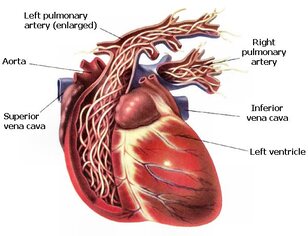 Every dog owner has heard horror stories of heartworm, and your own dog may even be on a heartworm preventative, but we still get questions about exposure, prevention, and treatment all the time. For a lot of pet owners heartworm is that thing they’ve heard of but don’t know too much about, so we’re using this as a chance to take a deep dive on the subject! To start with the basics, heartworm is a type of parasite that takes up residence in the arteries and hearts of a number of animal species, dogs included. When allowed to develop, heartworm populations can obstruct blood flow and cause irritation to the arteries, meaning an infection can potentially turn life threatening without proper intervention. Fortunately heartworm is both preventable and treatable, so let’s learn more about how to mitigate the risks of this nasty little parasite.  Image courtesy of ttdr.org/heartworm-information-and-prevention/ Image courtesy of ttdr.org/heartworm-information-and-prevention/ Transmission Heartworm is transmitted via mosquito bite. Mosquitos can feed off other infected animals (including those of other species), picking up heartworm larvae in the process. When the mosquito then flies to another prey and feeds again, the heartworm larvae are deposited and take up residence in their new host. The larvae burrow through tissues until reaching the bloodstream, and typically arrive at the heart six to seven months after initial exposure. Symptoms and Diagnosis Signs of a heartworm infection can vary greatly, but usually center around the heart and lungs. Infected dogs may be lethargic, and may exhibit coughing, exercise intolerance, shortness of breath, or other breathing difficulties. If a vet suspects your dog has an infection they will order a blood test to confirm the presence of heartworm. Treatment Heartworm treatment typically consists of a series of injections, with the specifics varying based on whether your dog is infected with immature heartworms (called microfilariae) or adult heartworms. These injections are administered with us in-house, and your dog may be kept for monitoring after treatment is given. These injections typically need to be spaced out, so treatment often involves multiple visits. It’s also important to keep your dog rested as they undergo heartworm treatment. As heartworms are dying off and breaking down they can travel through the lungs and bloodstream, so heavy exercise can increase the risk of complications during recovery.  Prevention If that last section sounded scary, there’s good news! An ounce of prevention is worth a pound of cure, and heartworm prevention is both easier and cheaper than treating an active infection. Heartworm preventatives are safe medications, typically given orally once per month. While some folks discontinue heartworm preventatives during the winter months, we advise continuing them year-round for a number of reasons. Just as with fleas and ticks, all it takes is one unseasonably warm January day for mosquitoes to be rearing their ugly probosci, leading to possible exposure even when it seems like they should be safe. Since heartworms take so long to travel from the skin to the heart, monthly heartworm treatments also help to kill off microfilariae already present in your dog’s body; a heartworm preventative given in February can help to eradicate an exposure from September. Many commercial heartworm preventatives also offer protection against other common parasites, such as hookworm or roundworm, so there’s that many more reasons to use them! Questions? Still have more questions about heartworm? Worried your pet is showing symptoms, or need to get them on a preventative? Get in touch! As usual we’ve got way more information than can possibly fit in these blog posts, and we’re always happy to share. Comments are closed.
|
|
OFFICE HOURS:
Monday-Friday: 8:00 am to 6:00 pm Saturday: 8:00 am to 12:00 pm |
CONTACT INFORMATION:
Concord Animal Hospital 245 Baker Avenue Concord, MA 01742 Phone: (978) 369-3503 Fax: (978) 371-9748 [email protected] |
JOIN OUR PACK!
Sign up for our monthly newsletter, the Paw Press for hospital news, pet care tips and cute pet photos! |
Copyright © 2022
